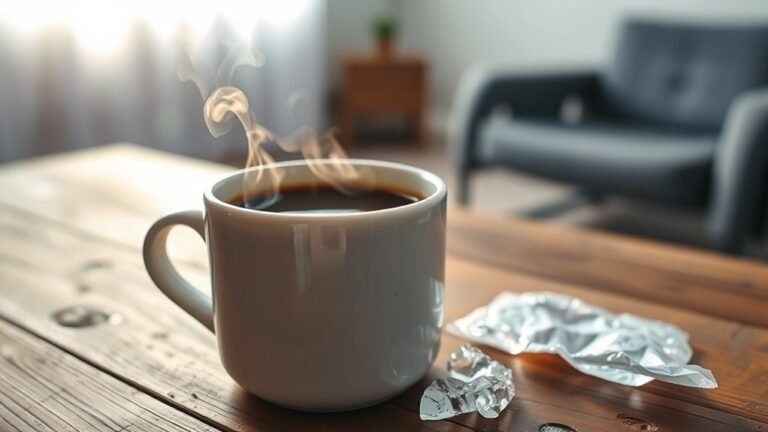The Art of Coffee Cupping: How to Evaluate Coffee Flavor
To evaluate coffee flavor expertly, you start by smelling freshly ground beans to capture aroma intensity. Use consistent tools—like a burr grinder and digital scale—to prepare uniform samples. Brew at precise temperatures, then taste by slurping to spread flavors evenly, focusing on acidity balance, body, and aftertaste. Record your notes immediately to track subtle nuances. This analytical process sharpens your palate and reveals coffee’s distinct profiles, inviting deeper exploration into each cup’s complexity.
Understanding the Basics of Coffee Cupping

Coffee cupping is a systematic method used to evaluate the aroma and flavor profile of coffee beans. When you engage in cupping techniques, you’re precisely measuring how different coffees express specific flavor profiles. You start by smelling the dry grounds, then steeping them in hot water to release the coffee’s essential characteristics. Once brewed, you break the crust, inhaling deeply to detect nuanced aromas. Using a spoon, you taste the coffee by slurping it, which aerates the liquid and spreads it across your palate, allowing you to discern acidity, sweetness, bitterness, and body. Mastering these steps liberates you to identify unique qualities in each coffee, enabling informed choices and deeper appreciation. This analytical approach lets you experience coffee beyond brewing, revealing its full potential.
Essential Tools and Equipment for Cupping
To conduct a thorough coffee cupping, you’ll need specific tools like cupping bowls, spoons, and a reliable scale. Setting up your equipment correctly guarantees consistent measurements and accurate flavor assessment. Let’s examine the must-have items and how to arrange them for ideal results.
Must-Have Cupping Tools
Five essential tools form the foundation of an effective cupping session, each designed to guarantee accuracy and consistency in evaluating coffee profiles. You’ll need them to maintain proper cupping etiquette and effectively navigate the flavor wheel. Precision is key, so every tool must be dependable.
| Tool | Purpose |
|---|---|
| Cupping Bowls | Uniform size for consistent coffee volume |
| Cupping Spoons | Designed for tasting and slurping |
| Grinder | Delivers consistent grind size |
| Scale | Measures coffee and water weight precisely |
| Timer | Guarantees exact steeping and evaluation time |
With these tools, you’re equipped to explore coffee’s nuanced flavors while respecting the methodical standards that free your palate to discern every detail.
Proper Equipment Setup
Setting up your cupping equipment correctly is essential for obtaining reliable and repeatable results. Begin by organizing your coffee cupping setup: confirm you have standardized cupping bowls, spoons, a precise scale, and a consistent grinder. Equipment calibration is critical—regularly verify your scale and grinder settings to maintain consistent grind size and dose. Use a thermometer to monitor water temperature, aiming for around 200°F (93°C) to extract peak flavors. Position your setup in a well-lit, odor-free space to prevent sensory interference. By meticulously calibrating and arranging your tools, you create an environment that allows you to evaluate coffee flavor objectively and freely. This disciplined approach confirms your assessments reflect true coffee characteristics, empowering you to explore and appreciate coffee’s complex profiles with confidence.
Selecting and Preparing Coffee Samples
When selecting coffee samples, you need to prioritize beans that display uniform size, roast level, and origin to guarantee consistency. Grinding must be precise, using a burr grinder set to a medium-coarse grind to optimize extraction without over-extraction. These steps are essential for accurate flavor profiling during cupping.
Choosing Quality Beans
Although selecting quality beans might seem straightforward, it requires careful consideration of origin, roast level, and freshness to guarantee accurate evaluation during cupping. You’ll want to focus on single origin beans, as their unique flavor profiles reveal distinct tasting notes linked to specific bean varieties and sourcing methods. Understanding roasting levels is essential; under or over-roasted beans can mask true flavors, skewing your assessment. Freshness factors, such as roast date and storage conditions, directly impact aroma and taste integrity. Prioritize ethically sourced beans to support sustainable practices and secure consistent quality. By meticulously choosing your coffee samples, you empower yourself to experience the authentic characteristics that define each coffee’s identity, preserving your freedom to explore diverse and nuanced flavor dimensions during cupping.
Proper Grinding Techniques
Because grind size directly influences extraction consistency and flavor clarity, mastering proper grinding techniques is essential for accurate coffee cupping. You need to select a grind size that matches the cupping method—typically a medium-coarse grind—to guarantee balanced extraction. Equally important is grind uniformity; inconsistent particle sizes can lead to uneven extraction, masking true flavor profiles. Use a quality burr grinder to achieve consistent grind size and uniformity, avoiding blade grinders that produce irregular particles. Grind your coffee samples immediately before cupping to preserve freshness and prevent flavor degradation. By controlling these variables precisely, you free yourself from guesswork and guarantee that each cup reflects the coffee’s authentic characteristics, empowering you to evaluate flavor with confidence and clarity.
Grinding and Measuring Coffee for Consistency
Three critical factors determine the quality of your coffee cupping results: grind size, grind uniformity, and the exact amount of coffee used. Achieving consistent results depends on mastering precise grinding techniques. Use a burr grinder to control particle size, ensuring uniform extraction and revealing true coffee flavors. Avoid blade grinders, which produce uneven grounds that skew taste perception. Measuring accuracy is equally essential—use a digital scale to weigh your coffee to the gram. Even slight variations in dose affect extraction balance and flavor clarity. By standardizing these variables, you liberate yourself from guesswork, allowing objective evaluation of each coffee’s profile. This disciplined approach sharpens your palate and enhances the freedom to explore nuanced flavor distinctions in every cupping session.
Evaluating the Aroma of Coffee Grounds
When you begin evaluating the aroma of coffee grounds, focus on the distinct fragrance notes that emerge immediately after grinding. Assess the aroma intensity and identify key elements of the scent profile. Your goal is to detect subtle nuances that reveal the coffee’s origin and processing method. Use your nose methodically—inhale deeply and note changes over time as volatile compounds dissipate.
| Aroma Intensity | Scent Profile | Notes to Detect |
|---|---|---|
| High | Fruity | Citrus, Berry |
| Medium | Nutty | Almond, Hazelnut |
| Low | Earthy | Soil, Moss |
| Variable | Floral | Jasmine, Rose |
| Consistent | Spicy | Cinnamon, Clove |
This analytical approach empowers you to explore coffee’s aromatic freedom with precision.
The Brewing Process in Coffee Cupping

Although evaluating aroma sets the stage, the brewing process in coffee cupping is essential for revealing the coffee’s full flavor potential. You’ll want to use standardized brewing methods to maintain consistency, ensuring each sample is treated equally. Precise control over water temperature—ideally between 195°F and 205°F—is critical, as deviations can under-extract or over-extract flavor compounds, skewing your evaluation. Measure your coffee dose and grind size meticulously to match the cupping protocol, allowing ideal extraction. Pour water evenly over the grounds, saturating them fully to promote uniform bloom and infusion. By mastering these variables, you’ll access the coffee’s nuanced profiles and complexities, giving you the freedom to discern subtle differences objectively and accurately. This disciplined approach is the foundation for reliable and insightful coffee cupping.
Tasting Techniques: Assessing Flavor and Acidity
With the brewing process fine-tuned to extract the coffee’s full range of flavors, your focus now shifts to tasting techniques that highlight key attributes like flavor and acidity. Begin by slurping the coffee sharply; this aerates the liquid, spreading it across your palate to reveal the complexity of flavor profiles. Pay close attention to the acidity balance—whether it’s bright and citrusy or muted and smooth—since this defines the coffee’s liveliness and freshness. Note how acidity interacts with sweetness and bitterness; a harmonious balance signals quality. Use a systematic approach: isolate distinct flavor notes, then assess their intensity and duration. By refining your palate through deliberate, analytical tasting, you’ll reveal nuanced insights and gain the freedom to appreciate coffee’s diverse expressions fully.
Identifying Body and Mouthfeel Characteristics
How do you accurately discern the body and mouthfeel of a coffee? Focus on the coffee viscosity and tactile sensations as the brew moves across your palate. These elements define the coffee’s physical presence and how it interacts with your senses.
- Notice the weight of the coffee—light, medium, or heavy on your tongue.
- Observe the texture—is it silky, creamy, oily, or dry?
- Detect the coating effect—does it linger or dissipate quickly?
- Assess the balance between smoothness and roughness during sipping.
Recording and Comparing Your Coffee Cupping Scores

Accurate recording is essential to make the most of your coffee cupping sessions. You need a consistent system for score tracking that captures each coffee’s attributes precisely—aroma, acidity, body, and aftertaste. Use a standardized cupping form or digital tool to log your flavor notes and numerical scores immediately after tasting. This guarantees you capture fleeting perceptions before they fade. Comparing scores across sessions reveals patterns and preferences, helping you refine your palate and select beans that truly resonate with your taste. By maintaining detailed, organized records, you gain the freedom to revisit past evaluations objectively, avoiding reliance on memory alone. This analytical approach empowers you to make informed decisions and elevates your appreciation of coffee’s nuanced complexities.
Frequently Asked Questions
How Often Should Professional Cuppers Recalibrate Their Palate?
Imagine your palate as a finely tuned instrument, like a compass that guides you through complex flavor landscapes. To maintain accuracy, you should recalibrate your palate through consistent palate training at least weekly, ensuring flavor consistency. This disciplined routine helps you detect subtle notes and avoid sensory fatigue, preserving your freedom to explore coffee’s nuances with precision. Regular recalibration sharpens your sensory perception, keeping your evaluations both reliable and insightful.
Can Coffee Cupping Detect Defects in Green Coffee Beans?
Yes, you can detect defects in green coffee beans through cupping techniques. By carefully analyzing aroma, flavor, and aftertaste during cupping, you enhance defect identification. These defects might include off-flavors like sourness, fermentation, or mold. Your precise and detail-oriented approach allows you to discern subtle irregularities, ensuring quality control. Mastering these techniques gives you the freedom to select and appreciate only the best beans for your brew.
What Are Common Mistakes Beginners Make During Cupping?
Before you immerse yourself, beware common pitfalls in cupping techniques that can skew your results. Beginners often rush the process, missing subtle flavor descriptors that reveal coffee’s true character. You might also neglect proper grinding consistency or let the coffee cool too quickly, dulling aromas. Keep your palate neutral—avoid strong foods or scents beforehand. Mastering these details frees you to accurately evaluate and appreciate each coffee’s unique profile.
How Does Altitude Affect Coffee Flavor Profiles in Cupping?
When you evaluate coffee from high altitudes, you’ll notice high altitude impacts that intensify its flavor. The cooler temperatures slow bean maturation, leading to denser beans with more concentrated sugars and acids. This enhances flavor intensity, giving you brighter acidity and complex aromatic profiles. So, during cupping, expect sharper clarity and nuanced notes. Understanding these effects lets you appreciate how altitude shapes coffee’s unique character, offering you a richer tasting experience.
Is It Possible to Cup Decaffeinated Coffee Effectively?
Can you truly reveal the soul of decaf flavor through cupping techniques? Absolutely—you can. While decaffeination alters some compounds, precise cupping still uncovers nuances in aroma, acidity, and body. You’ll need to adjust your palate, focusing on subtler notes often masked by caffeine’s bitterness. By refining your approach, you gain freedom to appreciate decaf’s unique profile, ensuring your evaluation remains as analytical and detailed as with any coffee.






